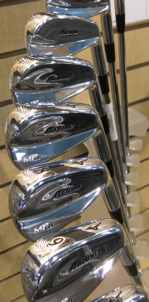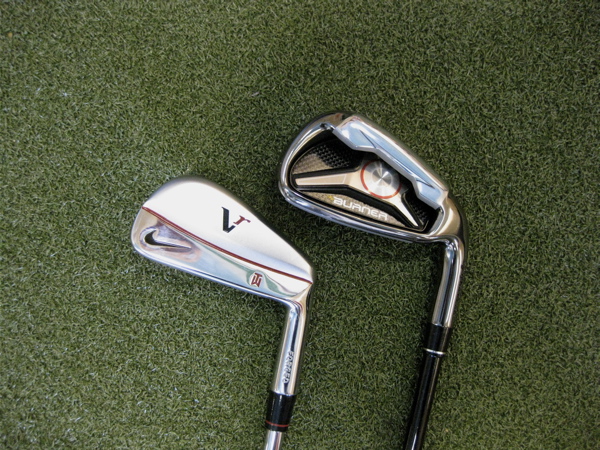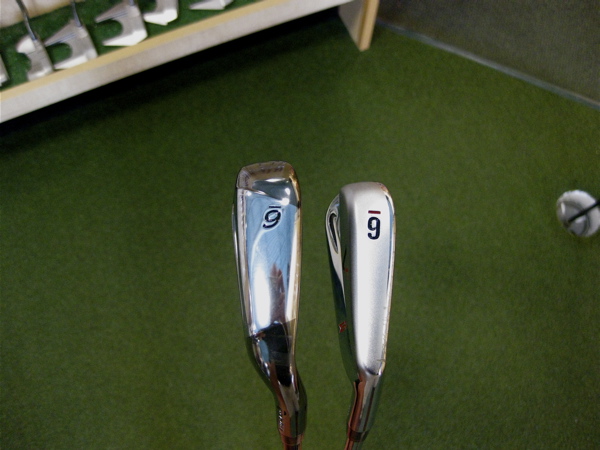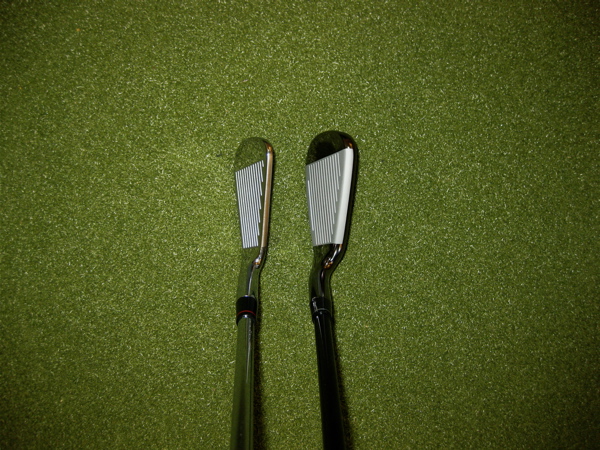We’ve covered the driver, and now it’s time to discuss irons. In this post, we’ll address the basics. Next time, we’ll talk about how to make sure you get an iron with specs that fit your swing.
So let’s get to it. When shopping for irons, the three basic decisions you’ll need to consider are:

1. Cast or Forged?
Cast irons are made by pouring molten metal into a mold. Forged irons, on the other hand, are made by pounding and shaping a heated chunk of metal. Cast irons tend to be harder, forged irons softer. If you like a harder feel at impact, go with cast. If you like a softer, sweeter feel, go with forged. In the end it’s simply a matter of preference.
One other consideration is that cast irons tend to be more brittle than forged irons. While softer forged irons are easily bent to adjust loft and lie angles, cast irons are not. So, if you decide to buy cast irons that need to be adjusted (we’ll discuss the importance of getting the right fit next time), it would be wise to custom order them from the manufacturer instead of having the golf shop bend them (and possibly break them) for you.

2. Muscle-back or Cavity-back?
Muscle-back and cavity-back refer to the way the back of the iron is shaped. Muscle-back irons (sometimes referred to as “blades”) are solid chunks of metal. Cavity-back irons literally have a cavity dug into the back of the club. Take a look at the picture to the left — the club on the left is the Nike Victory Red Tiger Woods tour blade (muscle-back), and the one on the right is the Taylor Made Burner (cavity-back). The design of the cavity-back allows for a reallocation of mass that makes for a more forgiving club. Generally speaking, cavity-back irons will create higher, longer, and straighter shots on mishits. On the other hand, muscle-back irons provide more workability (the ability to draw and fade the ball). Better players have traditionally preferred the workability that comes with a muscle-back, but because muscle-back irons are virtually impossible to hit consistently, even the best players in the game are recognizing the futility of blade irons. In short, unless you share your first name with a large solitary cat, you would be absolutely crazy to play muscle-back irons. More on this in a minute.
3. Player’s club or Game-improvement club?
This distinction is very much related to point #2 above. Most reputable club manufacturers (Ping, Titleist, TaylorMade, etc.) make two lines of irons – player’s irons and game improvement irons – and they market each to a different segment of the golf population. Player’s irons tend to have shallower cavity-backs (or no cavities at all, like the Nike blades above), narrower soles (the sole is the part of the club that rests on the ground at address), a thinner top line (the top edge of the clubhead as you look down from above), and they tend to be smaller. The sleek, no frills look and feel of a player’s iron gives more workability but less forgiveness. Player’s irons are designed for “players” – low handicappers.

Game-improvement irons are designed for (you guessed it) the rest of us. They have deeper back cavities and wider soles. This design places the center of gravity lower to the ground and further back, which makes it easier for the average golfer to get the ball up in the air. Game-improvement irons also tend to have larger clubheads and a thicker top line. The larger clubhead creates more stability and a larger sweet spot, which means more forgiveness on mishits. Take a look at the image to the right — again, these are the Nike tour blade on the right (player’s club) and the Taylor Made Burner on the left (game-improvement club). Notice the difference in sole width and overall size of the head. The image below shows the difference in the top line when looking down at the club as you would when you address the ball. Note the thin top line and the small head of the Nike blade on the left.

For the Proud Among Us
Okay, now that you’re armed with the important information, start thinking about the type of iron design that would be best suited for your game. Most golfers, even single-digit handicappers, could benefit from an iron that is more forgiving. If you’re a good player who is too proud to make the switch away from your unforgiving muscle-back blades (you know who you are!), consider the fact that KJ Choi, the 37th ranked player in the world, played the 2010 Masters with Ping G15 irons. G15’s are some of the largest, bulkiest, game-improvement-est irons you’ll find. He hit high, straight iron shots all week, finished tied for 4th, and never once was ridiculed for playing wussy clubs!
In the next post we’ll discuss getting the right fit on your irons – shaft type, length, lie angle, and grips.
